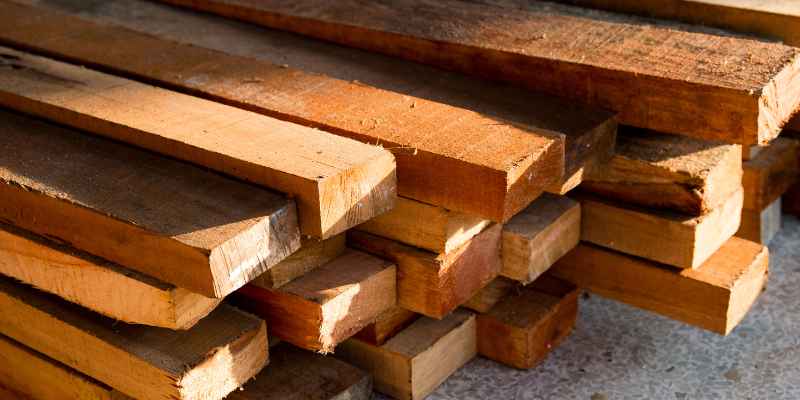Yes, almond wood is considered a hardwood. It comes from the almond tree, which is classified botanically as a hardwood species.
Almond wood is gaining popularity in various applications, thanks to its durability and aesthetic appeal. Known for its rich, warm tones, this wood is often used in furniture, cabinetry, and flooring. Its fine grain and smooth texture make it an excellent choice for detailed woodworking projects.
The wood is also resistant to warping and splitting, adding to its longevity. Many artisans and homeowners appreciate almond wood for its unique character and sustainability. As more people seek eco-friendly materials, almond wood stands out as a responsible choice that combines beauty and functionality. Explore the benefits of using almond wood for your next project.
Introduction To Almond Wood
Almond wood comes from the almond tree, mainly found in California. This wood is known for its rich color and beautiful grain. It is classified as a hardwood, making it strong and durable.
Almond wood has a fine texture that makes it easy to work with. It is often used in furniture, cabinets, and decorative items. The wood also has a natural resistance to decay.
| Common Uses of Almond Wood |
|---|
| Furniture |
| Cabinets |
| Decorative items |
| Musical instruments |

The Hardwood Vs. Softwood Debate
Hardwood and softwood are classified based on their source. Hardwood comes from deciduous trees, while softwood comes from coniferous trees. This basic difference leads to various characteristics.
Hardwood is usually denser and more durable than softwood. It often has a more complex grain pattern. Softwood tends to grow faster and is lighter.
Many people use hardwood for furniture and flooring. Softwood is commonly used for construction and paper products. Understanding these differences helps in choosing the right type of wood.
| Criteria | Hardwood | Softwood |
|---|---|---|
| Source | Deciduous Trees | Coniferous Trees |
| Density | Higher | Lower |
| Grain Pattern | Complex | Simpler |
| Common Uses | Furniture, Flooring | Construction, Paper |
Almond Wood Properties
Almond wood is known for its unique properties. It is classified as a hardwood. This means it is durable and strong. The density of almond wood ranges from 40 to 44 pounds per cubic foot. Its hardness rating is about 1,200 on the Janka scale.
The color of almond wood can vary. It often features a light brown hue with darker streaks. The grain patterns are usually straight and tight. Some pieces may show a wavy or curly grain, adding to its beauty.
Comparing Almond Wood To Popular Hardwoods
Almond wood is a unique material. It has qualities that can be compared to popular hardwoods like oak, maple, and cherry.
| Wood Type | Density | Durability | Appearance |
|---|---|---|---|
| Almond | Medium | Moderate | Light to dark brown |
| Oak | High | Very durable | Golden brown |
| Maple | High | Very durable | Light cream to reddish-brown |
| Cherry | Medium | Moderate | Rich reddish-brown |
Each type of wood has its own features. Oak is known for its strength. Maple offers a smooth finish. Cherry has a warm color that deepens over time.
Environmental Impact Of Using Almond Wood
Almond wood is considered a sustainable choice for many reasons. It comes from almond trees that often grow in orchards. After their productive years, these trees are usually cut down.
This practice helps reduce waste and supports replanting efforts. New trees are planted to replace the old ones. This cycle promotes a healthy ecosystem.
Using almond wood also lowers the ecological footprint. It requires less energy compared to other hardwoods. This means a smaller impact on our environment.
Many suppliers focus on responsible sourcing. They ensure that almond wood is harvested in eco-friendly ways. This adds to its appeal as a sustainable material.
Working With Almond Wood
Almond wood is a hardwood that offers great qualities for various projects. It is dense and durable, making it suitable for furniture and cabinetry.
When machining almond wood, use sharp tools for smooth cuts. This wood can splinter, so take care during the process. A router can create clean edges and profiles.
For the finishing process, sanding is essential. Start with a coarse grit and finish with a fine one. This helps achieve a smooth surface that highlights almond wood’s natural beauty.
Using a high-quality finish will protect the wood and enhance its color. Consider oil finishes for a natural look. Regular maintenance keeps almond wood looking great for years.
Almond Wood In Design And Architecture
Almond wood is a popular choice in modern design and architecture. Its rich color and unique grain patterns add beauty to any space. This wood is often used for furniture, cabinets, and flooring. Designers love its durability and aesthetic appeal.
Historically, almond wood has been valued for its strength. It has long been used in various cultures for crafting tools and art. Today, it connects history with contemporary design.
| Application | Description |
|---|---|
| Furniture | Stylish tables, chairs, and cabinets made from almond wood. |
| Flooring | Durable and attractive flooring options for homes and businesses. |
| Art | Used in sculptures and decorative pieces for its beauty. |
Final Thoughts: The Verdict On Almond Wood
Almond wood is indeed a hardwood. Its density makes it strong and durable. This wood is often used for furniture and cabinetry.
Pros of almond wood include its beautiful grain and rich color. It resists warping, which is great for various projects. Cons include its higher cost compared to softwoods.
Consider your project needs before choosing almond wood. It works well for high-quality items. If budget is a concern, explore other options.
| Pros | Cons |
|---|---|
| Beautiful grain | Higher cost |
| Durable | Limited availability |
| Resists warping | Can be heavy |

Frequently Asked Questions
Is Almond Wood Considered A Hardwood?
Yes, almond wood is classified as a hardwood. It comes from deciduous trees, which lose their leaves annually. Hardwoods are generally denser and stronger than softwoods. Almond wood is known for its durability and beautiful grain, making it popular for furniture and cabinetry.
What Are The Benefits Of Almond Wood?
Almond wood offers several benefits. It is durable and resistant to wear, making it ideal for furniture. Additionally, its fine grain and rich color enhance aesthetic appeal. Almond wood also has natural oils that provide some resistance to pests, adding to its longevity and overall value.
How Does Almond Wood Compare To Other Hardwoods?
Almond wood is comparable to other hardwoods in density and strength. However, it has a unique grain pattern and color that sets it apart. While woods like oak and maple are common, almond wood provides a distinct look for furniture.
Its durability makes it a reliable choice for various applications.
Is Almond Wood Sustainable?
Yes, almond wood can be considered sustainable. Almond trees are often cultivated for their nuts, and the wood is a byproduct. This practice helps reduce waste and promotes responsible forestry. However, always source wood from reputable suppliers to ensure sustainable practices are followed in harvesting.
Conclusion
Almond wood is indeed classified as a hardwood. Its durability and aesthetic appeal make it a popular choice for furniture and flooring. Choosing almond wood can enhance the beauty of your space while providing lasting quality. Consider this versatile material for your next woodworking project or home improvement.

